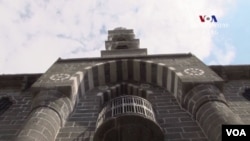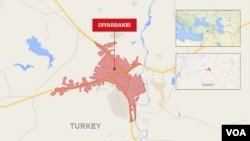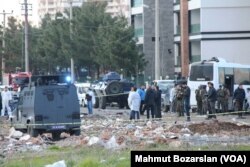A service last year in the newly restored Armenian church of Surp Giragos brought members of the small ethnic Armenian minority together with members of the international Armenian diaspora.
The restoration of the church — one of the largest Armenian churches in the southern Turkish city of Diyarbakir — was a powerful symbol of hope for the renewal of the country’s ethnic Armenian community.
But that hope faded earlier this year as reports surfaced that the Turkish government expropriated Surp Giragos and six other churches.
Gaffur Turkay, of the Surp Giragos Foundation, said the expropriation raises dark memories.
“The law says our churches have been expropriated,” he said. “But when we ask, the authorities say, ‘No, they haven't.' We have experienced this before. In 1936, all of our properties were taken and we are still fighting to get them back. We are not unfamiliar with this; we have anxiety, fear, because we don't know.”
Church’s importance
The controversy over expropriations is one of the latest chapters in the effort to restore the historical quarter of Diyarbakir, which has been badly damaged in months of fighting between the Kurdish rebels and Turkish security forces.
The city's local authority, run by the pro-Kurdish HDP party, has financially supported the restoration of Surp Giragos as part of its efforts to make Diyarbakir a multiethnic religious center.
"Diyarbakir was an Armenian town before the genocide” that began in 1915, said political scientist Cengiz Aktar. “Hardly anyone is left, and the restoration of this church was very significant. Both the Armenian community and local authorities were asserting themselves through the restoration of this church. The restoration of it had [a] widespread echo in the Armenian community worldwide."
The church of Surp Giragos had become a place where ethnic Armenians whose families had converted to Islam were rediscovering their identity and faith. But the renewed fighting between the PKK and the government has resurrected historical prejudices and suspicions regarding ethnic Armenians.
‘Fear in all of us’
Government ministers have linked Armenians to the Kurdish rebels, and anti-Armenian graffiti allegedly painted by Turkish security forces can be seen across the city.
“There is fear,” said one member of Diyarbakir's ethnic Armenian community, who did not want to be identified. “There is fear in all of us. What was done to the Armenians in 1915 is now being done to Kurds. It is the same mentality, same logic. This happened to us before — this genocide, the deaths. We don't want to live it again.”
A year ago in Diyarbakir, a cease-fire with the PKK rebels was entering its third year.
That peace enabled the city and its people to rediscover their rich multiethnic and religious past, powerfully symbolized by the restoration of Surp Giragos. Observers warn that the return of war has replaced hope with fear, especially for the region's tiny Armenian minority.











